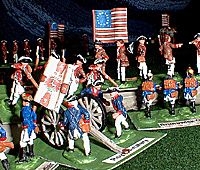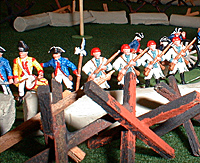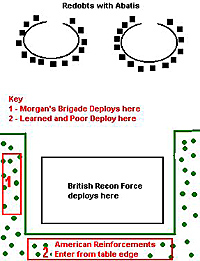 Historical Background:
Historical Background:
Everyone remembers that Benedict Arnold was a traitor during the Revolutionary War. What is often forgotten is that prior to his treachery he was America's finest general. Perhaps his greatest display of leadership and courage was at the second battle of Saratoga, also known as Bemis Heights. It was at this battle that Arnold led a successful American attack against a British fort. His victory eventually forced General Burgoyne to surrender his army, and gave the French the encouragement they needed to declare war on the British. It was the turning point in the war, and one of the most important battles in American History.
After Action Reports: This game was played with two different groups of middle school students.
Battle 1: The first time we fought the battle the outcome was almost identical to what happened back in 1777. The Americans ambushed a British force that had foolishly strayed too far from their forts. While some of the Americans pinned the British in place other regiments raced to attack the lightly defended redoubts. The British commander reacted immediately and sent the British grenadiers to smash the small American force. Soon the swiftest American units were approaching the first fort and drawing British and Hessian regiments like moths to a candle. This made it possible for another American force, led by Benedict Arnold, to move behind the second British fort and attack it from the rear. They succeeded in taking the fort at bayonet point, but Arnold was wounded in the charge. This battle was ruled a slim American victory.
 Battle 2: History was changed in the second battle. Despite some heroic efforts the Americans were unable to capture either of the British forts. The desperate Americans launched
charge after charge against the British grenadiers and light infantry, and were bounced every time. The stalwart redcoats held the center and right flank against every American attack.
The determined Americans finally broke when their commander was killed leading yet another charge against the grenadiers. The hopes of the Americans fell on a small force of militia
and continental line that had slipped by the British and managed to reach the redoubts. Once again Benedict Arnold led the final
assault, and was wounded. This time, however, the Americans couldn't take the position. This battle was a narrow British
victory.
Battle 2: History was changed in the second battle. Despite some heroic efforts the Americans were unable to capture either of the British forts. The desperate Americans launched
charge after charge against the British grenadiers and light infantry, and were bounced every time. The stalwart redcoats held the center and right flank against every American attack.
The determined Americans finally broke when their commander was killed leading yet another charge against the grenadiers. The hopes of the Americans fell on a small force of militia
and continental line that had slipped by the British and managed to reach the redoubts. Once again Benedict Arnold led the final
assault, and was wounded. This time, however, the Americans couldn't take the position. This battle was a narrow British
victory.
 Set Up: The British Recon force must start the game deployed in the clearing. The remaining British forces must start in one of
the redoubts. Learned and Poor's brigades may start anywhere in the woods in front of the British, and Morgan's brigade may
start in the woods on the right flank of the British.
Set Up: The British Recon force must start the game deployed in the clearing. The remaining British forces must start in one of
the redoubts. Learned and Poor's brigades may start anywhere in the woods in front of the British, and Morgan's brigade may
start in the woods on the right flank of the British.
Sequence of Play
Declare Charges
Charge Morale Checks
Both sides move
Both sides fire
Morale checks
Melees
Movement: Infantry units may move 6" in line, and 12" in column. It costs ½ a move to change formation. Militia takes a full move to change formation. Artillery moves 3" per turn. Commanders may move 24". Units must stay at least 1" away from enemy units unless they are charging.
Formations: Infantry may be deployed in line or column. Lines may be single or double rank, and may bend. Columns are single company. The British light infantry and Virginia Rifles may deploy in line with up to one stand width between stands.
Morale Checks: Roll 1D6 and apply any modifiers. The roll must be equal to or less than the number of remaining stands to pass. Butler's Rangers, the artillery, and the Indians always have a morale of four. If artillery fails a morale check they will abandon the guns. They may return to the guns later in the game if they get the chance.
Morale Die Roll Modifiers
Militia +1
Charging or being charged with no bayonets +1
Grenadiers, Lights, Morgan's Brigade -1
Commander within 6" -1
When to Check Morale, and the Consequences of failing your roll
1. Before charging - If the unit passes it may charge. If it fails it must stand in place this turn (It may fire).
2. When being charged - If the unit passes it will stand and receive the charge. It may fire at the charging unit at a range of 1". If the unit fails it will lose one stand and run away 12" in column formation. The unit must spend the next turn reforming. Militia units that fail this morale check are removed from play.
3. After losing a stand to enemy fire - A unit that loses a stand, and has 4 or fewer stands remaining must check morale. If the unit fails it runs away 12" in column and must spend the next turn reforming. A militia unit that fails is removed from play.
Shooting: Roll one die for each stand that is firing (units which are charging may not fire). Consult the table to see the numbers needed to hit. Remove one enemy stand for each hit. If the target is in column formation, or if you are firing at its flank then roll one extra die. Units in line may fire both ranks if they are deployed in double rank line. Column formation may only fire the lead stand. Reloading: Militia units and the Virginia Rifles take one turn to reload. You can mark units which need to reload with a cotton puff, and remove the cotton when they are reloaded. They may not fire during the turn that they reload, but they may move. All other units may fire every turn.
| Firing Table | |||
|---|---|---|---|
| Range | 1" | 6" | 12" |
| Musket | 5-6 | - | 6 |
| Rifle | 5-6 | 5-6 | 6 |
| Field Cannon | 4-6 | 5-6 | 6 |
| Redoubt Cannon | 4-6 | 4-6 | 5-6 |
Commanders: A commander gives a morale benefit to any units under his command that are within 6".
However, if any of these units lose a stand to enemy fire then roll 1D6 for each stand lost this turn. If the roll is a 6 then the officer is a casualty. Roll again for the results:
- 1 - Hat shot off head, no effect
2, 3, 4 - Wounded, remove from play, all units under his command must take a morale check
5,6 - Killed, all units under his command must take a morale check with a +1 penalty on the roll. The officer is removed from play.
An officer may also lead a charging unit. He gives the unit a benefit in the melee, but roll one die to see if he is a casualty regardless of the outcome. If the roll is a 6 then roll again on the officer casualty chart to see the result. Benedict Arnold and General Burgoyne may give a benefit to any unit on their side. This is in addition to any benefit from the unit's commander.
Melee: If a charging unit contacts an enemy unit there will be a melee. Each side rolls a die and applies the modifiers. High roll wins. The loser removes a stand and retreats 12". He must spend the next turn reforming. If the roll is a tie each side removes a stand and rolls again.
Melee Die Roll Modifiers
More stands than opponent +1
Hitting the flank or rear +1
Commander leading charge +1
Militia unit -1
No bayonets -1
Defending redoubt wall +2
Grenadier +1
Attacking the redoubt: To attack the walls of the redoubt the abatis must be cleared first. A unit must spend one turn in contact with the abatis to clear it. The unit must not move during the turn that it is clearing the abatis, and it must pass any morale checks caused by enemy fire. Once the abatis is clear attackers may charge units defending the wall. The walls will protect the defenders from enemy fire. If a unit defending the wall is hit by enemy fire roll 1D6 for each hit. If the roll is a 1-4 then there is not effect, if the roll is 5-6 the hit counts.
Orders of Battle: The Virginia Rifles have rifles; all other infantry units have muskets. Units marked with an * do not have bayonets. The number of stands in each unit is indicated inside the parentheses.
British
Recon Force - Gen. Burgoyne
Right Wing - Gen. Fraser
Butler's Rangers (1)*
Indians (1)*
British Light Infantry (6)
British 24th Foot (5)
2 Field Cannons*
Left Wing - Gen. Von Riedesel
British Grenadiers (6)
Brunswick Von Spaeth Regiment (6)
2 Field Cannons*
In Redoubts - von Breymann
Canadian Militia (2)
Brunswick Von Specht Regiment (5)
Brunswick Grenadiers (6)
2 Redoubt cannons*
Americans
Morgan's Brigade - Daniel Morgan
Virginia Rifles (4)*
Dearborn Light Infantry (4)
Learned's Brigade - Gen. Learned
2nd Mass (4)
8th Mass (4)
9th Mass (4)
NY Militia (4)*
Poor's Brigade - Gen. Poor
1st NH (4)
2nd NH (4)
3rd NH (4)
1st NY (4)
2nd NY (4)
4th NY (4)
1st Conn Militia (4)*
2nd Conn Militia (4)*
Enter Turn Two:
Patterson's Brigade - Gen. Patterson
10th Mass (3)
11th Mass (3)
12th Mass (3)
14th Mass (3)
Glover's Brigade - Gen. Glover
1st Mass (3)
4th Mass (3)
13th Mass (3)
15th Mass (3)
2nd Albany Militia (3)*
Duchess & Ulster Militia (3)*
Gen. Benedict Arnold
Useful Resources
1776 - Wargaming Rules and a Guide to the American War of Independence by Jay Facciolo and Joe Miceli
"Saratoga Order of Battle" by Wesley A. Rogers, Citadel 1996
Sons of the Revolution, http://www.walika.com/sr/
Warflag, http://www.warflag.com/
Back to SJCW The Volunteer Summer 2001 Table of Contents
Back to SJCW The Volunteer List of Issues
Back to Master Magazine List
© Copyright 2001 by SJCW
This article appears in MagWeb (Magazine Web) on the Internet World Wide Web.
Other military history articles and gaming articles are available at http://www.magweb.com